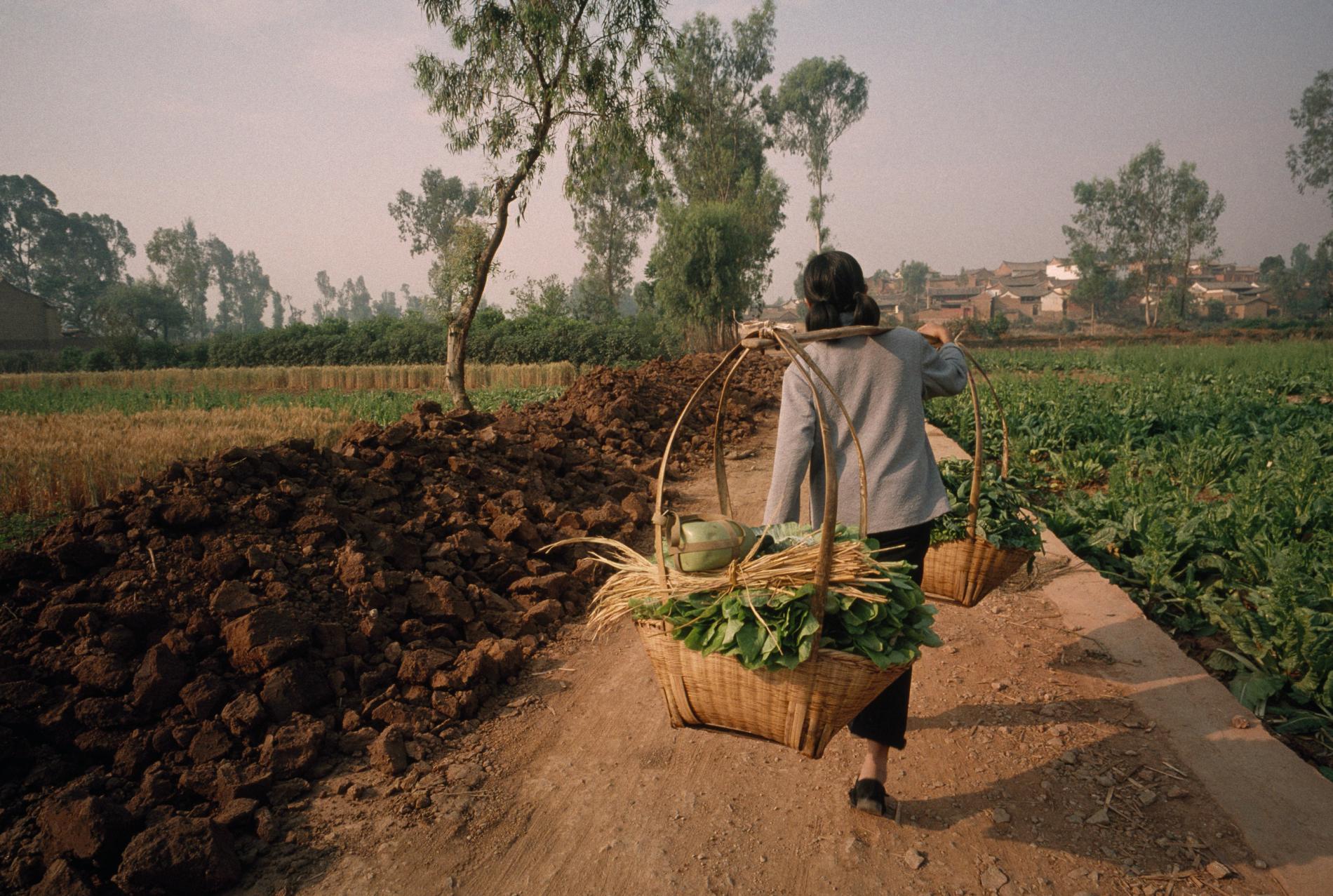As a result of both recent environmental pressures and an expanding urban population, the Chinese diets of southern rice and northern wheat are growing increasingly difficult to satisfy, leading the nation away from self-sufficiency and toward a crippling food and water security crisis. To resolve these pressing issues, the Chinese government collaborated with development experts to explore multiple solutions. A sustainable answer was found in the promotion of the sweet potato as a Chinese staple, in addition to wheat and rice.
Though China possesses only 7% of the world’s agricultural area, with only 12% of the nation’s land being arable, it boasts the largest population on Earth. Hence, according to research done by Lu Chunxia and colleagues, the siren call of China’s rapid economic development has clustered its booming population within its urban areas, drawing farmers from their fields and toward a more profitable labor (359). The sufficiency of Chinese agriculture is thus decreasing, even as the population rises. They further note a significant “northbound shift” and “westward expansion” in Chinese agricultural hubs during recent years (Lu et al. 360). This hints at yet more developmental paradoxes faced by the nation: with drought raging its northern farmlands, urbanization disabling its productive eastern fields, and irrigation efforts expediting water scarcity throughout its inarable and impoverished lands to the west.
While Dr. Lu and her colleagues’ research identifies a correlation between China’s shift to arid farmlands and its growing food security issues, Professor Gu Xihui and his fellow environmental scientists collected data concerning changes in the nation’s precipitation levels. Specifically, intense flooding in the South and extreme drought in the North. The conclusion of their research was that China should set an example in facing climate change by enacting “more measures… [such as] water resources laws… [and] conservancy projects,” in addition to developing technology to help reduce the limitations imposed by “resource shortages” (Gu et al. 503). Studies such as the two mentioned above hold the primary evidence used by development experts and the Chinese government to promote and sanctify the drought and flood resistant sweet potato as the next staple crop of China. Research and legislation, however, can only reach so far.
The Chinese history of sweet potato cultivation is rather intricate. Tied to times of famine and instances of terrible poverty, it is these connections which render the crop—however essential or brilliant a solution it may appear to be—unpalatable and unattractive to most Chinese people. Nevertheless, by understanding the role sweet potatoes have played in alleviating China’s suffering, in addition to acknowledging the crop’s essentialness to the continued prosperity of Chinese society, even the most stubborn of cultural stigmas can be rewritten. It is, therefore, the attachment of the sweet potato to ideas of success, perseverance, and cultural sentiment which will deliberately yet progressively transform it into the solution for growing Chinese socioeconomic concerns.
Copy & paste below link for full-screen view:
https://uploads.knightlab.com/storymapjs/f7abeb5e40d1b6b3218ccc33f41165b0/fys-digital-research-project-sweet-potatoes-in-china/index.htmlWorks Cited:
Chan, Gerald. “China and Small States in Food Security Governance.” African and Asian Studies, vol. 13, no. 1–2, 2014, pp. 59–79. EBSCOhost, search.ebscohost.com/login.aspx?direct=true&db=ant&AN=XRAI15K06Z-552&site=ehost-live.
“China and the Sweet Potato.” Argenpapa, 13 Nov. 2018, www.argenpapa.com.ar/noticia/6666-china-china-and-the-sweet-potato.
Accessed 11 Nov. 2020.
Chunxia, Lu, et al. “Changes in China’s Grain Production Pattern and the Effects of Urbanization and Dietary Structure.” Journal of Resources & Ecology, vol. 11, no. 4, July 2020, pp. 358–365. EBSCOhost, doi:10.5814/j.issn.1674-764x.2020.04.004.
Dou, Eva. “China Pushes ‘Clean Plate’ Push amid Food Supply Squeeze.” The Washington Post, 5 Oct. 2020, www.washingtonpost.com/world/asia_pacific/china-food-shortage-clean-plate/2020/10/02/578daa0e-0223-11eb-b92e-029676f9ebec_story.html.
Accessed 12 Nov. 2020.
Gardner, Hannah. “Forget Rice and Noodles, China Looks to Potatoes as the New Staple.” USA Today, 10 Feb. 2016, www.usatoday.com/story/news/world/2016/02/10/forget-rice-and-noodles-china-looks-potatoes-new-staple/80050200/. Accessed 11 Nov. 2020.
Gu, Xihui, et al. “Spatio-Temporal Changes and Their Relationship in Water Resources and Agricultural Disasters across China.” Hydrological Sciences
Journal/Journal Des Sciences Hydrologiques, vol. 64, no. 4, Apr. 2019, pp.
490–505. EBSCOhost, doi:10.1080/02626667.2019.1587170.
Horta, Loro. “Chinese Agriculture Goes Global.” YaleGlobal Online, 16 Dec.
2014. Yale.edu, yaleglobal.yale.edu/content/chinese-agriculture-goes-global.
Accessed 10 Nov. 2020.
Jia, Ruixue. “Weather Shocks, Sweet Potatoes and Peasant Revolts in Historical China.” Economic Journal, vol. 124, no. 575, Mar. 2014, pp. 92–118.
EBSCOhost, doi:10.1111/ecoj.12037.
Klein, Jakob A. “Creating Ethical Food Consumers? Promoting Organic Foods in Urban Southwest China.” Social Anthropology , vol. 17, no. 1, Feb. 2009,
pp. 74–89. EBSCOhost, search.ebscohost.com/login.aspx direct=true&db=bas&AN=BAS365204&site=ehost-live.
Liu, Zhouhong “Sandy.” Interview. 10 Oct. 2020.
Lu, Hanchao. “The Tastes of Chairman Mao: The Quotidian as Statecraft in the Great Leap Forward and Its Aftermath.” Modern China, vol. 41, no. 5, Sept. 2015, pp. 539-72. JSTOR, doi:10.1177/0097700413517640. Accessed 10 Oct. 2020.
Qiao, Michelle. “Sweet Potatoes Started a New Era in Farming.” Shanghai Daily, 2 Dec. 2016. Shine, archive.shine.cn/feature/art-and-culture/Sweet-potatoes-started-a-new-era-in-farming/shdaily.shtml. Accessed 11 Nov. 2020.
Tian An Men square, Beijing, China.. Photograph. Britannica ImageQuest, Encyclopædia Britannica, 31 Aug 2017. quest.eb.com/search/300_404904/1/300_404904/cite.
Accessed 5 Nov 2020.
Xinhua News Agency. “Experts Suggest Using More Potatoes to Feed Chinese Population.” Xinhua News Agency [Bejing], 30 Mar. 2004. World News Connection, wnc.eastview.com/wnc/simple/doc?art=1&id=35575674. Accessed 10 Oct. 2020.
—. “Potato Brings New Wealth to Impoverished Western China.” Xinhua News Agency [Beijing], 23 Sept. 2010. World News Connection,
wnc-eastview-com.wooster.idm.oclc.org/wnc/simple/doc?art=0&id=32465545. Accessed 12 Nov. 2020.
—. “Water Scarcity Threatens Food Security in Asia-Pacific: FAO Assistant
Director-General.” Xinhua News Agency [Beijing], 22 Mar. 2012. World
News Connection, wnc-eastview-com.wooster.idm.oclc.org/wnc/simple/doc?art=0&id=32465545. Accessed 12 Nov. 2020.
